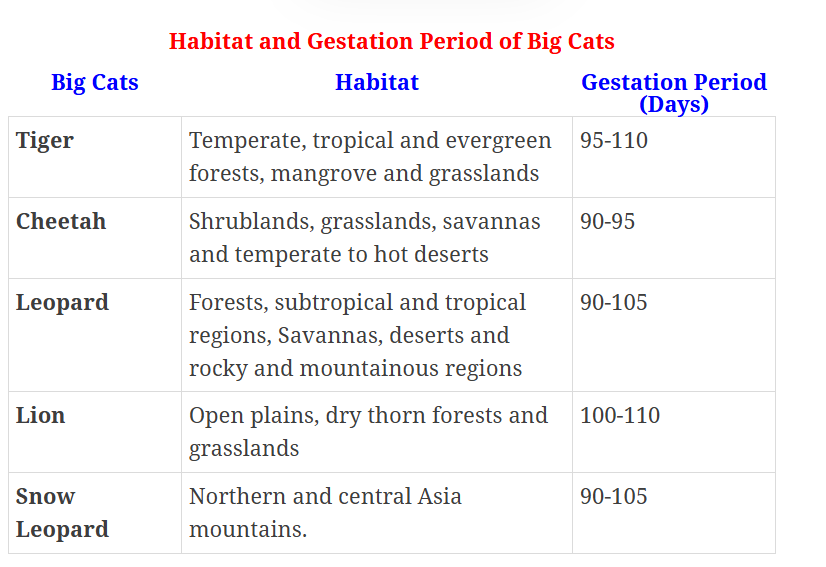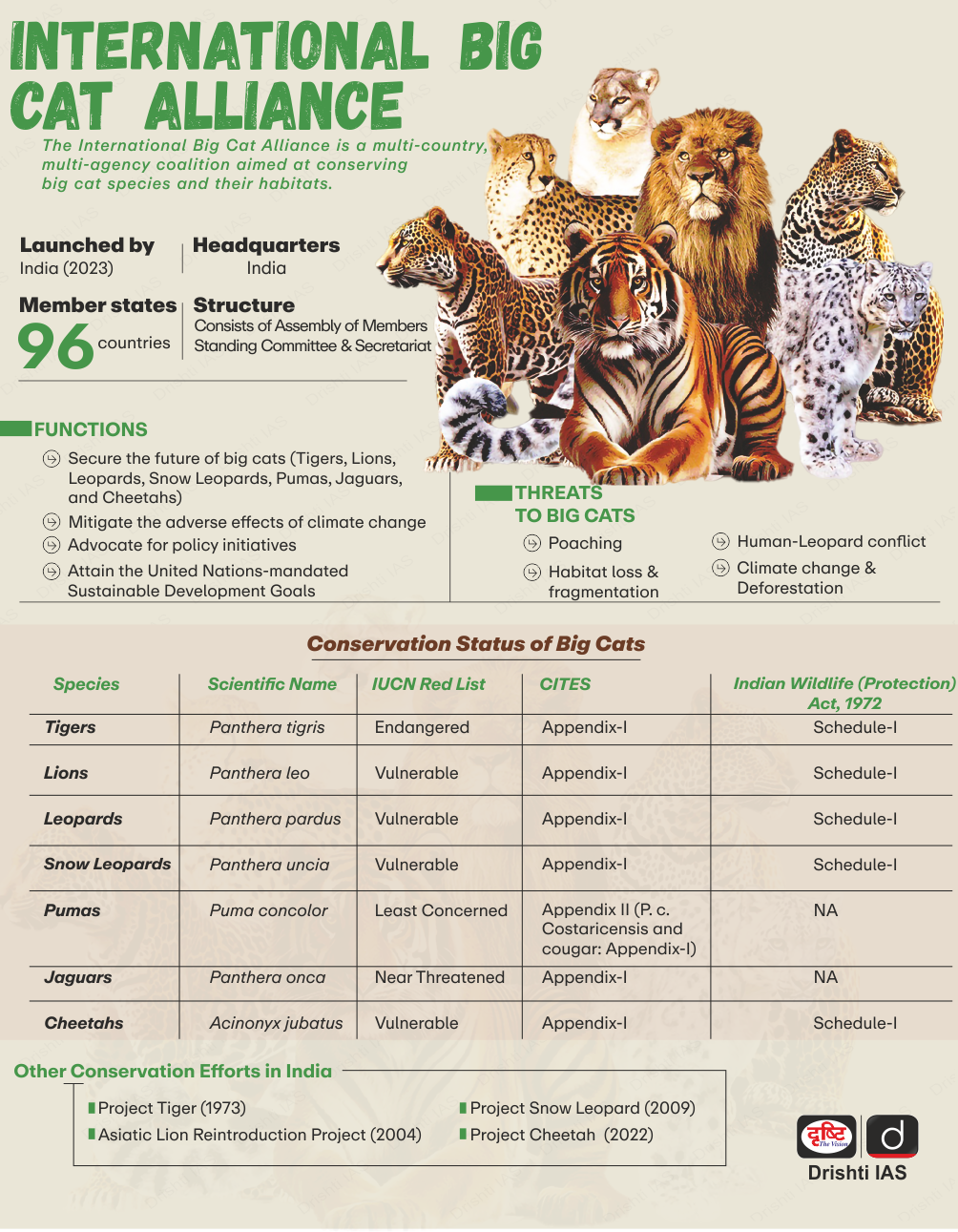Important Facts For Prelims
International Big Cat Alliance
- 06 Feb 2025
- 6 min read
Why in News?
The International Big Cat Alliance (IBCA) officially became a treaty-based intergovernmental organization and international legal entity on 23rd January 2025 with headquarters in India.
What is the International Big Cat Alliance (IBCA)?
- Origins: IBCA was launched by Prime Minister Narendra Modi in 2023 during the 50th anniversary of Project Tiger, and was formally approved by the Union Cabinet in February 2024.
- Implementation: IBCA established through the National Tiger Conservation Authority (NTCA) under the Ministry of Environment, Forest & Climate Change (MoEFCC).
- It functions as a global platform to share conservation expertise, fund conservation initiatives, and create a repository of technical knowledge.
- Objective: The initiative’s main objective is the conservation of seven major big cat species: the Tiger, Lion, Leopard, Snow Leopard, Cheetah, Jaguar, and Puma.
- Membership: The Republic of Nicaragua, Kingdom of Eswatini, Republic of India, Federal Republic of Somalia, and Republic of Liberia have ratified the IBCA framework agreement.
- Membership is open to all United Nations member states, including range countries where these species naturally occur and non-range countries interested in supporting big cat conservation.
- Need for IBCA: Big Cats are under threat due to habitat loss, poaching, climate change, and human-wildlife conflicts.
- Conservation at a global scale is required to halt population decline and reverse negative trends.
- Funding: India has committed Rs. 150 crore (2023-2028) in support to the IBCA and is exploring additional funding through bilateral, multilateral, and donor organizations.
- Role in Conservation Efforts:
- Collaborative Conservation Platform: IBCA creates a global network of conservationists, policymakers, researchers, and governments.
- Facilitates sharing of best practices in habitat management, anti-poaching strategies, and ecological restoration.
- Financial and Technical Assistance: Acts as a common funding pool for conservation projects worldwide.
- Provides technical know-how and scientific research to under-resourced nations.
- Strengthening Existing Agreements & Initiatives: Works alongside CITES (Convention on International Trade in Endangered Species), CMS (Convention on Migratory Species), and other wildlife protection treaties.
- Aims to support national and regional big cat conservation programs.
- Climate Change Mitigation & Ecological Security: Conservation of apex predators like big cats ensures healthy ecosystems, biodiversity preservation, and climate resilience.
- Restoration of forests and grasslands through IBCA initiatives will aid in carbon sequestration and climate adaptation.
- Collaborative Conservation Platform: IBCA creates a global network of conservationists, policymakers, researchers, and governments.
National Tiger Conservation Authority (NTCA)
- The NTCA, a statutory body under the MoEFCC, was established in 2005 following the Tiger Task Force's recommendations and gained legal status under Section 38L of the Wildlife (Protection) Amendment Act, 2006.
- Objectives: Grants statutory authority to Project Tiger, ensures federal accountability in tiger reserve management and addresses local livelihood concerns around tiger reserves.
Conservation Efforts for Big Cats in India
UPSC Civil Services Examination Previous Year Question (PYQ)
Q. Consider the following statements: (2019)
- Asiatic lion is naturally found in India only.
- Double-humped camel is naturally found in India only.
- One-horned rhinoceros is naturally found in India only.
Which of the statements given above is/are correct?
(a) 1 only
(b) 2 only
(c) 1 and 3 only
(d) 1, 2 and 3
Ans: (a)
Q. Consider the following statements: (2024)
- Lions do not have a particular breeding season.
- Unlike most other big cats, cheetahs do not roar.
- Unlike male lions, male leopards do not proclaim their territory by scent marking.
Which of the statements given above are correct 2
(a) 1 and 2 only
(b) 2 and 3 only
(c) 1 and 3 only
(d) 1, 2 and 2
Ans: (a)
Q. Consider the following: (2012)
- Black-necked crane
- Cheetah
- Flying squirrel
- Snow leopard
Which of the above are naturally found in India?
(a) 1, 2 and 3 only
(b) 1, 3 and 4 only
(c) 2 and 4 only
(d) 1, 2, 3 and 4
Ans: (b)






